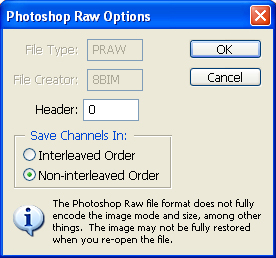
Azure A's List: Art
-
-
pretty much every file on your computer has a file header containing various data, such as what type of file it is, how large it is, and so on. most of the time, you need to carefully avoid bending the file header, because corrupting the header is the easiest way to break the file (with rare exceptions). photoshop RAW format allows us to avoid dealing with headers at all, simply by typing 0 into the header box. if you have a RAW file with no header, you can do just about anything you want to it—bend it in any way you can imagine—and it will still open.
-
-
-
in addition to the header, PSD (photoshop) files have a patch of must-not-bend data in between each channel. furthermore, the rule for not adding/subtracting byte applies to each channel of a PSD file. since it can be impossible to tell exactly where a channel begins or ends, you should expect these files to break frequently.
-
PSD files have features not found in most other formats, which offer some advantages. one advantage is support for layers. by editing a multi-layered PSD in a wav editor, you can glitch one layer without glitching the others. here, i've copied lily (our kitten) onto her own layer, and bent only the layer underneath:
another trick involving layers is to use duplicate layers. if you copy an image to a second layer, and then bend the file, you can effectively create two databent copies of the image, simultaneously. of course, this also gives you more opportunities to mess up and break the file.
-
-
May 01, 13
“The chemical industry was growing hugely and they came up with all kinds of colors, but you never knew how long they would remain stable.” That was the case with van Gogh’s violet, used to depict the walls of his room in Arles. Because the red in the purple paint faded prematurely, probably even during van Gogh’s lifetime, it left behind only the blue with which it had been mixed.
-
“The Bedroom,” Vincent van Gogh’s 1888 painting, with its honey-yellow bed pressed into the corner of a cozy sky-blue room, is instantly recognizable to art lovers, with his signature contrasting hues. But does our experience of this painting change upon learning that van Gogh had originally depicted those walls in violet, not blue
-
“We now know much more about the pigments van Gogh used and how they might’ve changed color over time,” Ms. Bakker said. “That’s crucial to our understanding of his works, and to know better how to treat them. The colors are still very vibrant, but they would have been even brighter — especially the reds. Some of the reds were much brighter or have completely disappeared since he painted them.”
-
-
-
In other paintings the disappearance of the reds had different consequences. For example, in images of blossoming fruit trees, blossoms are now white that were once pink because the red faded away. That might lead to changing the identification of the type of tree depicted, Ms. Vellekoop said.
-
In a way, his use of complementary colors places van Gogh strictly in the traditions of his time. Although he was radical in his use of bright colors, she said, “he follows the traditional color theory that was already written down in the first half of the 19th century,” she said, adding, “A lot of his artist friends were reading those books,” but didn’t use the pigments so boldly.
-
-
-
The pigment is responsible for the color of the paint. They can be found throughout nature in clays, herbs, nuts, berries, barks, carbon, charcoal, and soot. They are ground down into powder and usually boiled several times in water to remove impurities
-
Lime wash on the other hand is washable. It is made from lime putty, water, and pigment. It has antibacterial properties, is durable, and ages well. Casein can also be added to increase durability. Both paints leave a chalky, matte finish and allow walls to breath
-
1 - 5 of 5
20 items/page
List Comments
(0)


